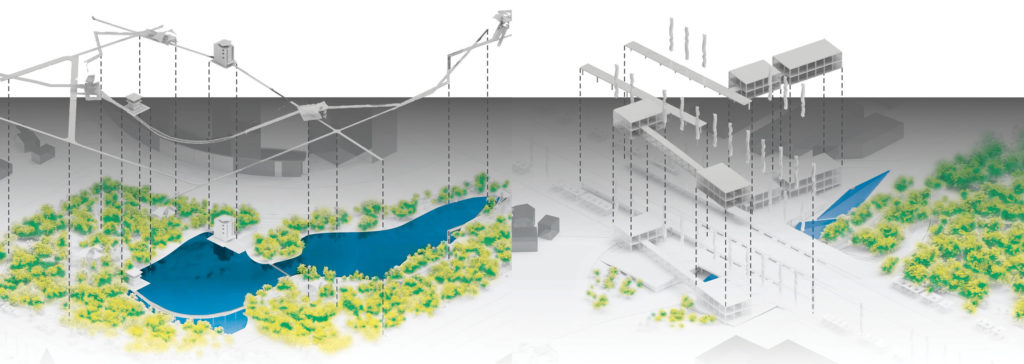What our jurors say about FuturArc Prize 2022 Entries
September 6, 2022
FuturArc Prize (FAP) 2022: Reinterpretation—one theme with the highest realisation potential in FAP’s 14-year run—asked students to reinterpret existing corporate/private/state-owned entities in Asia to transform them into civic/public spaces that give back to the community and are good, inviting, safe and sustainable. This challenge was set in the hope that the visions proposed could one day be transformed into reality.
Evaluation Criteria
The jury looked for solutions that are plausible, rooted in local conditions and are cross-disciplinary.
Decisions that are made on scale and delineation of site boundaries must be clearly explained. Entrants must also explain context in terms of why a particular current development has been selected, what the community needs are and the known impact on the environment. The submission must be presented clearly as a proposed reinterpretation of a private project to a public one with relevant reimagined natural and social layers as well as their contributions or purposes to the greater good.
From the entries received, three winners and eight merit recipients were awarded. Click through below to read about each entry.
• First Place | A Chronographic Blueprint: Reinstating the Valley of Hope
• Second Place | Biodivercity: A Story of Flight
• Third Place | Revival Waste: Propagating Permaculture
• Merits

Jurors’ Comments
OVERALL THOUGHTS
The competition has successfully triggered a lot of fresh ideas from the students to reinterpret architectural and landscape designs based on preservation, as well as environmental and economic values. These three aspects are interlinked and are important in facing the global issues of climate change and future sustainability. Most of the submissions deserve high recognition for showcasing provocative thoughts, fresh ideas and a new dimension for reinstating abandoned buildings and sites.
THREE NOTABLE IDEAS FROM THE COMPETITION
a) Environmentally sensitive ideas that focus on waste collection, reutilisation and production within a building.
b) Transforming an abandoned building complex to a nature sanctuary.
c) Integration of ecological design, environmental approaches and community space provision for economic growth.
OVERALL THOUGHTS
The quality of entries are all interesting and exciting; many ideas are worth piloting and some innovations can be further developed.
THREE NOTABLE IDEAS FROM THE COMPETITION
a) Integration beyond the built environment that includes programming and biodiversity.
b) Strong adaptive reuse concepts.
c) Integrated waste management.
OVERALL THOUGHTS
The entries demonstrate diversity in addressing urban spaces with different layers of interacting natural and human-made systems. The projects have shown high feasibility and replicability in cities that will increase economic value for local communities. Many new design solutions and ideas are presented convincingly, not only by analysis and visualisation, but also by proposing the latest technologies, materials and Green construction practices.
THREE NOTABLE IDEAS FROM THE COMPETITION
a) The renovation of abandoned buildings and infrastructure in urban areas with new functions contributes to solving real problems of urban waste, air quality, health and biodiversity.
b) High replicability with design solutions that are movable, adaptive and modular.
c) New functions and design strategies that respond to the COVID-19 pandemic and post-pandemic era with flexibility, incorporating the latest technology such as HEPA filters in public space.
OVERALL THOUGHTS
Most of the entries have displayed their own creativity in developing the concept based on the city’s context, but only some entries are outstanding in terms of their designs and presentations.
THREE NOTABLE IDEAS FROM THE COMPETITION
a) Reusing abandoned spaces in different city contexts as Asia has several abandoned sites.
b) Mixing architectural design with activities, agriculture and landscape, and how they can be applied to multiple sites.
c) Combining technology with designs could help turn many heritage sites into ‘magnets’ of activity.
[This is an excerpt. Subscribe to the digital edition or hardcopy to read the complete article.]
RELATED: Excerpts from FuturArc Prize 2022 Jury Meeting

RELATED: Not Just Buildings: Round-Table Discussion with FuturArc Prize 2022 Jurors

Read more stories from FuturArc 3Q 2022 Green Awards: Reinterpretation!

To read the complete article, get your hardcopy at our online shop/newsstands/major bookstores; subscribe to FuturArc or download the FuturArc App to read the issues.
Previously Published Main Feature
Contact us at https://www.futurarc.com/contact-us for older commentaries.
